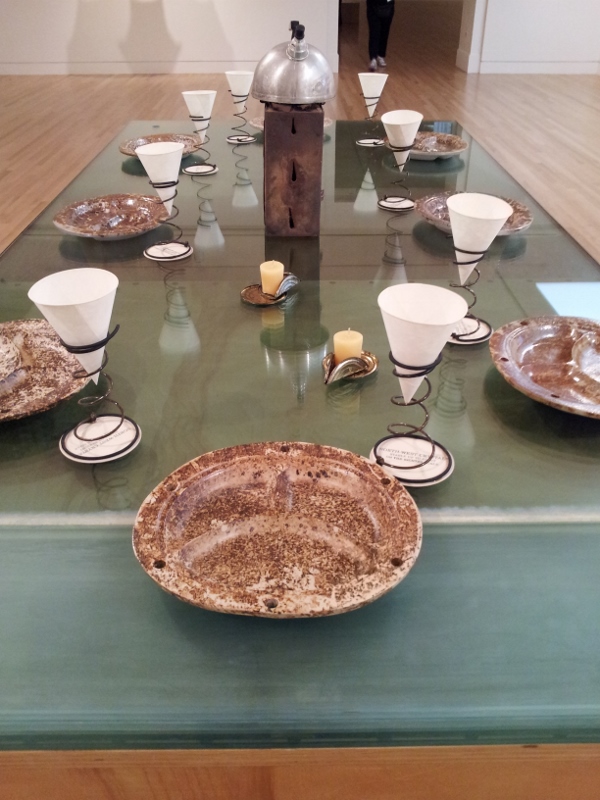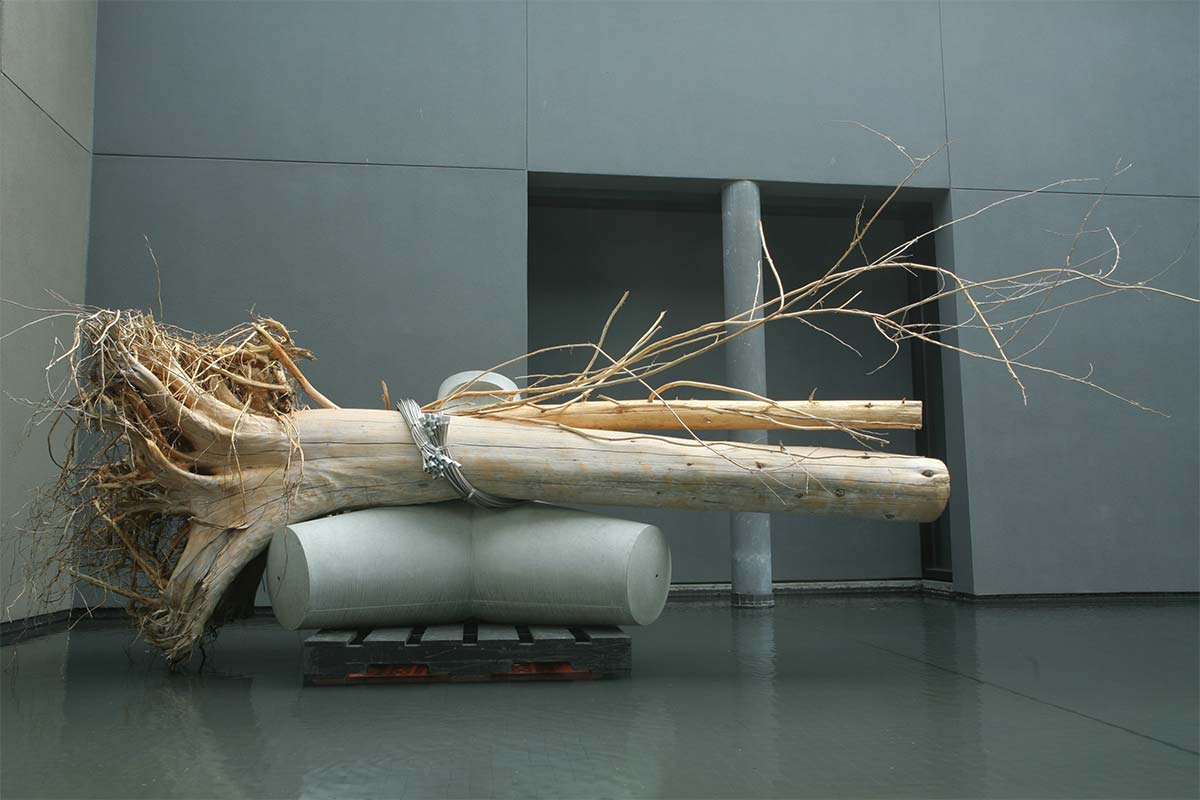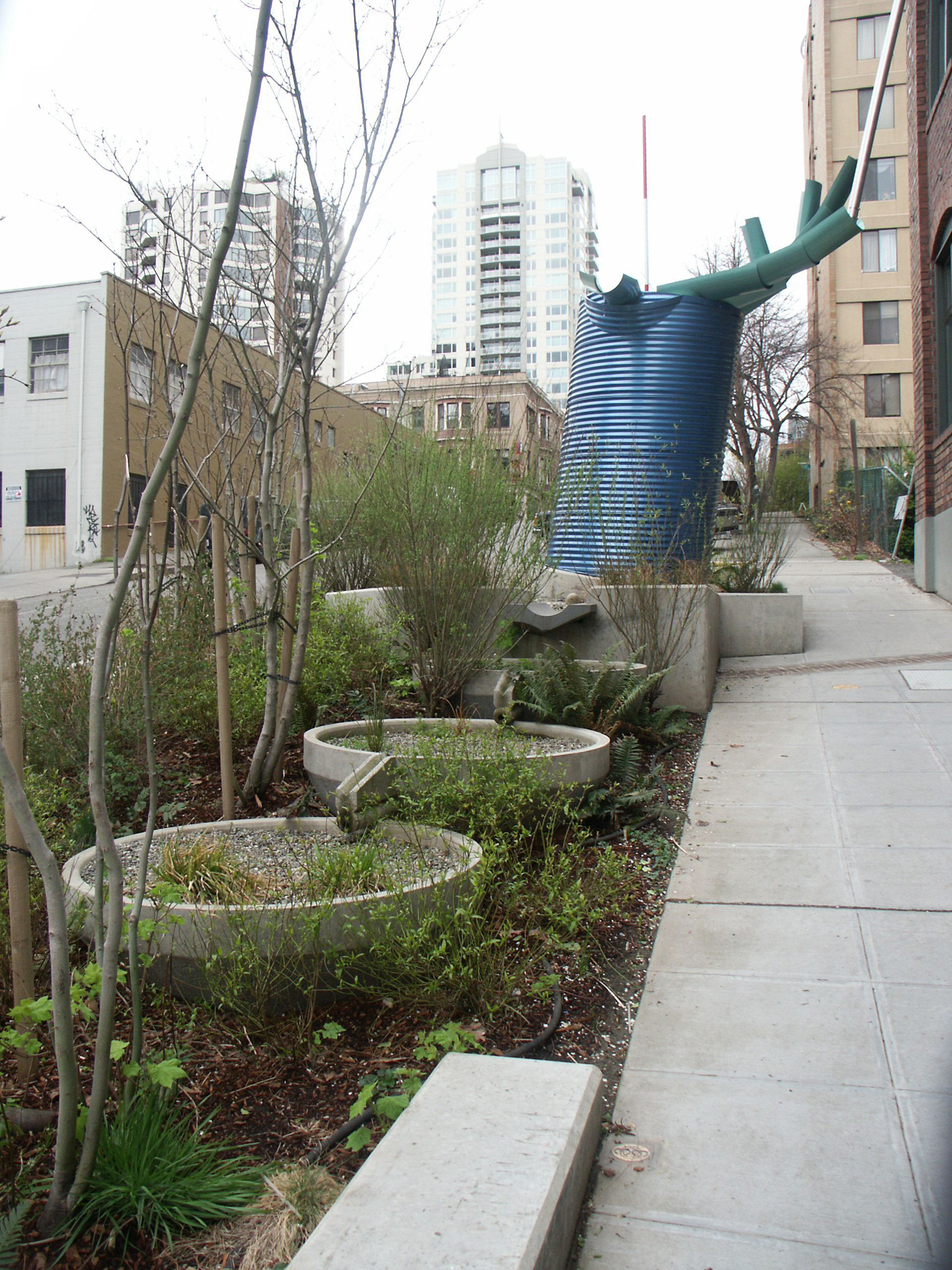Buster Simpson underwent a gradual change in his artistic career. He started as a performance artist, acting as the Woodman, gathering building debris from the streets of Seattle, and dumpster diving.
Image from Buster Simpson // Surveyor
Image from Buster Simpson // Surveyor
The Woodman is the epitome of incremental change. Whether or not he did anything with the materials he gathered, the streets were slowly cleaned. Yet the narrative propagated by these performances do not only impart a simple story of reusing materials. In fact, Jo-Anner Birnie underlines the subtly of this character quite effectively. She views him as bringing to attention the utopian goals of modern urbanization. By picking up each and every small piece of wood and discarded building material and piling them on his back, he is demonstrating the great lengths that go we go to create an artificial urban environment, clean from trash or useless materials sitting about, while in reality the buildings we craft are no more permanent than his sculptures of reclaimed materials (7). It is only a question of the degree of the force of nature. Wind and rain can will carry away small things, but intense storm and flooding will just as easily wipe away these larger interventions into the natural biophysical world.
“Everywhere we look, it is becoming harder to distinguish the rural from the urban.”
-Carol Yinghua Loo

Image from Catching Zebra
The installation Downspout-Plant Life Monitoring System is an example of the artist’s foray into sculpture, attempting to bridge the gap between nature and the city. The work itself consists of a simple fern growing from the rain-pipe attached to the side of a building. It is a small intervention, an incremental change to the fabric of the city, adding a small bit of green to an otherwise monotony of brick. Just like the Woodman, who leveraged incremental change to ascertain materials, Downspout also performs some function, de-acidifying the water running through the pipes (Matilsky 92-93). The three elements of Simpson’s work are well represented here- “[elegant] simplicity, cost [efficacy], and [easy implementation] on a large scale in cities around the country (96).”
Image from Buster Simpson // Surveyor
Tree Guards is primarily interested in directly displaying a message, just like the visceral image of a man burdened by the massive piles of wood he has collected from the streets. It speaks to incremental change in the environment, caused by humans. Lawrimore points that even the the meager attempts made by city planners, planting trees for example, are under threat by the inhabitants of the city themselves. They are often damaged as a result of drunken incidents on the sidewalk or street. (57). The tying of a crutch to a fledging urban tree is an elegantly simple way to bring attention back to nature and also offer a creative “solution” to the problems that urban trees face.

Image from Art and Politics Now
When the Tide is out the Table is Set also does not have a direct use, by instead serves as a way to monitor the toxicity of bodies of water surrounding Seattle. By leaving cast concrete plates in water for a time and then removing them, Simpson exposes the presence of toxins in the water, in the form of buildup on these plates (Matilsky 94). These plates were made by Simpson during a residency. This introduces the idea, oft seen in Simpson’s work, that humanity always has a direct hand in the affecting the environment, even when they are in the act of “restoring” it. A “technology”, the plates in this example, had to be invented for use in showing how humans affect the environment. The irony here is that the material used, concrete, is formed by separating out rocks and sand from the environment and re-fashioning them with human labor. This, of course, had an effect on the ecosystem from which the rock and sand was extracted. Even when in the process of monitoring, in the hopes of mitigating, environmental degradation in one region, this process directly contributed to it in another area.
This sort of subtle humor is explored further by Simpson in the titling of this work. It comes from an old Salish saying that conveyed the idea that the bountiful clean waters had produced a meal, yet Simpson’s work shows the opposite (95). The waters are no longer safe, and there is a certain dark humor in the use of that saying. This dark humor was essential part of a memorable performance of the Woodman in 1974. In an interview, Simpson recounts how he had gathered so much wood that when he stooped to grab more, he drops some of it (Lawrimore 92). He is forced into an odd dance that acts as a metaphor for the enduring efforts of humanity to elude itself when the environment is considered. We have already gone far in destroying the natural rhythms of the environment. Now we are attempting to restore the damage we have done, but we want to do it in a way that seems “natural”.

Image from Greg Kucera Gallery
We place root wads in riparian areas to help the river, but once they have been placed the story of human intervention in that area is silenced. Simpson humorously exposes this delusion in Secured Embrace. In the video, Buster Simpson on “Secured Embrace” at The Frye Museum, he describes the work as the “new woodman”. Upon further prompting about this statement he jokingly points out that the concrete structures that are tied to the log and serve to anchor it in the water are vaguely anthropomorphic. The final intent of the art piece is to be placed in a river to help restore its natural flows, but the large concrete structures that will remain continue to tell the story of human intervention. This also subtly makes a jab at the art world, wherein objects are usually rendered useless when they become “art”. Simpson’s work is anything but useless, while still functioning as “art” evidence by its placement in a museum. The Woodman has always been about showing what effect one person can have on their surrounding environment. In the case of the Woodman that environment was the city and the act served to bring attention to how our societal structures negatively affected some of the people that inhabited it, namely, the homeless. The large building projects from which the Woodman collected material were not low-income housing units. They were usually high-rises. There is a parallel with Secured Embrace here. This time, however; the environment being considered is the biophysical environment and the work is bringing to the public’s attention how those same societal structures are negatively affecting a different population, the species that make up our riparian ecosystems. In this second case, Simpson was very intentional in making sure that it was obvious the humans had a direct hand in this “restoration”, just as they had in its original degradation.

Image from Pinterest
A primary takeaway from Buster Simpson, I believe, is that small, deliberate changes, which contribute to society in a way that is pleasing or fulfilling, can carry a big impact. The final work I will discuss illustrates this above idea very clearly. Simpson’s work Exchanger Fountain is very simple. It consists of a drinking fountain that is in a symbiotic relationship with the Willow tree adjacent to it. The gray water from the fountain (the water that isn’t drunk) spills on to rock below the fountain. As the water evaporates, this process cools the pipes carrying water to the drinking fountain’s users, as well as watering the Willow tree (Oakes 123). Not only does this odd installation afford the users a break from the regularity of normal urban trees, but it also raises a question,
Why can’t more of our city’s spaces be put to simultaneously practical and artistic use?
How much more life does this simple and sustainable way of envisioning a drinking fountain add to the city than the customary separation of this two objects of civic life?
Simpson shows us that there is abundant room in our world to experiment creatively and constructively. When users drink from this fountain, they do not just get the nourishment of water, they also see their own faces amid the leaves of the Willow leaves (Allan 192). These subtle gestures, pairing the fountain with a tree and creating a space where people can see their reflections, inspire in the users thoughts of how their own relationship with water interacts with the flow of water on a wider scale. City dwellers often only think of water as the liquid pumped through underground pipes and appearing in their homes. The struggle of obtaining water is absent, as is the everyday exaltation in its life-sustaining properties. Inscribed on Exchanger Fountain is the phrase “The water kissing your lips is an offering (192).” This inscription serves as the final way in which the piece causes the viewer/user to reflect on the often unseen and neglected beauty of the natural world and its life-giving cycles.

Image from Daily Journal of Commerce
Widespread change to our increasingly large urban environments is an equally difficult task to conceive of and to put into motion. Building codes, statues, land use policies, apathy, and the feeling that one person’s contribution cannot make any sizable difference are all challenges that any urban innovator will face. Buster Simpson, in typical fashion, was able to find a way to begin affecting change despite these challenges. In a collaboration project called Growing Vine Street, Simpson helped transform the Vine Street area into a catalyst for sustainable solutions to urban problems related to sustainability, polluting, and runoff water (Thompson 222). This is remarkable because it demonstrates the power which art and science can wield in collaboration. What was essentially a sculpture park created an environment for others, with different mindsets and different backgrounds, to use the space to test out green ideas. The location also served as a community garden (222), which stays true to Simpson’s philosophy that “art in public” should have practical use value. A prime example is Cistern Steps -a project Simpson planned and implemented with community involvement. A series of tiered basins collects rainwater which flows from condo roofs, uses this water to nourish native species planted in the basins, and then directs it to Puget Sound (Bloom 60). The construction of this project involved the community, and is a way of subtly conveying the notion that more comprehensive and “ambitious” projects will be needed in the future (58). By elevating the water system above the ground and highlighting its movement in this way, the path that water takes through the city is made apparent, perfectly keeping in line with the eternal task of the Woodman – exposing the inner workings of the city and its ordinary rhythms.


